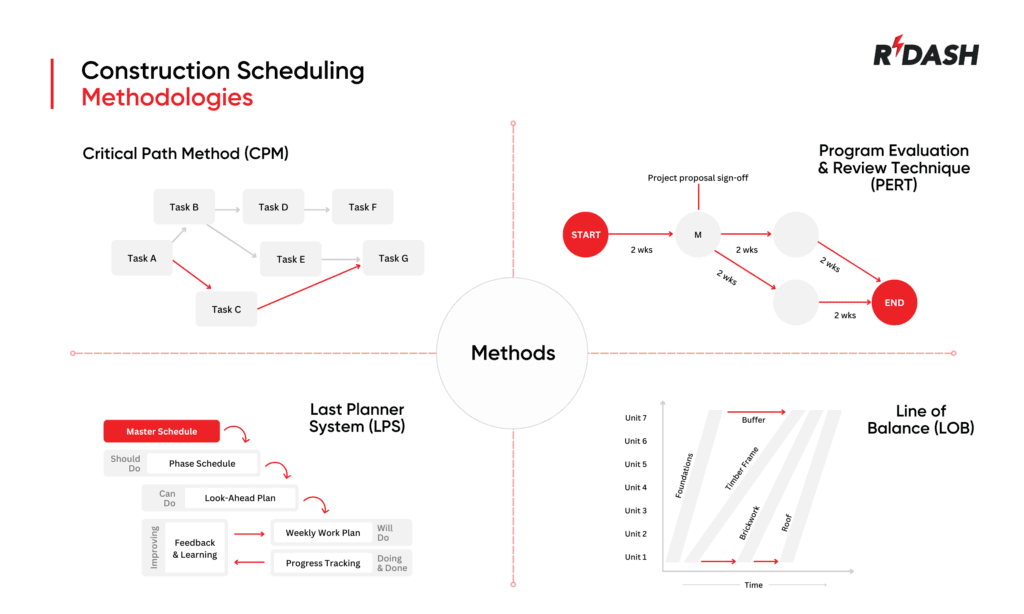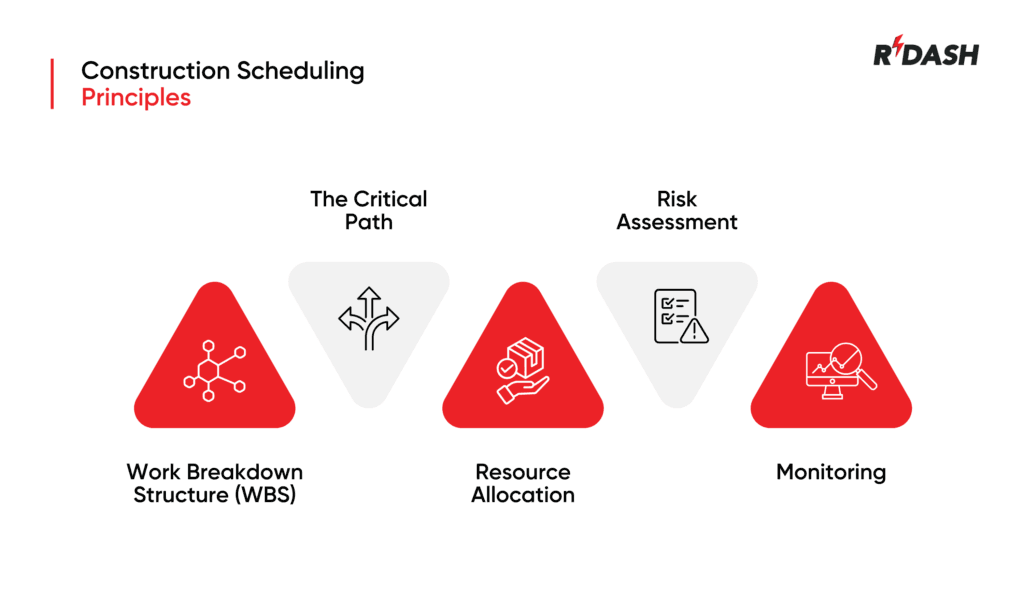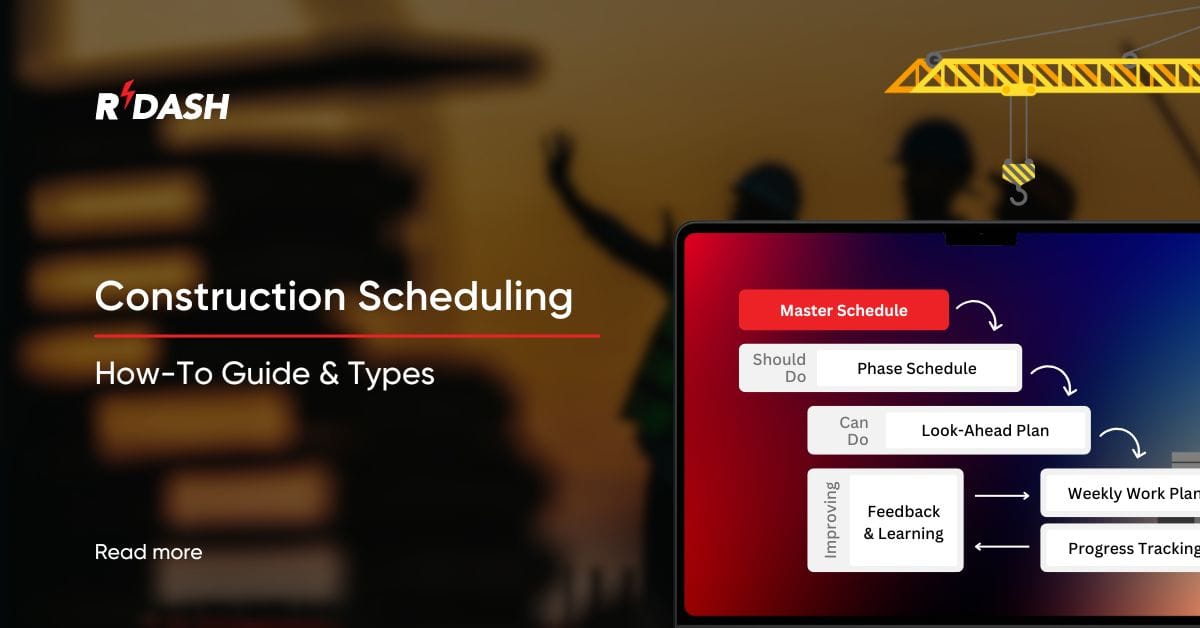Construction scheduling is a critical practice in the construction industry, serving as the backbone for managing both small-scale renovations and large-scale infrastructure projects. It involves creating a detailed roadmap that outlines the start and finish dates for various components of a construction project. Proper construction scheduling ensures that a project progresses smoothly, within budget, and on time, making it indispensable for project success.
What is Construction Scheduling?
Construction scheduling is the process of organizing and planning all the tasks and activities that need to be completed in a construction project. It helps project managers visualize the sequence and duration of all project phases, manage the workforce and resource allocation, and anticipate potential bottlenecks. Effective scheduling is vital for coordinating the various teams and resources involved, minimizing downtime, and enhancing overall project efficiency.
Key construction scheduling types
Construction projects can vary greatly in complexity and scope, which has led to the development of several construction scheduling methodologies tailored to different types of projects:

- Critical Path Method (CPM): The Critical Path Method is one of the most widely used scheduling techniques in construction. It involves identifying the longest sequence of dependent tasks that must be completed on time to ensure the project finishes by its deadline. CPM helps project managers identify which tasks can be delayed without affecting the overall project timeline and which ones are critical and must be prioritized.
- Last Planner System (LPS): The Last Planner System adopts a cooperative method that centers on controlling and planning production efficiently. It requires involvement from all levels of the project team to plan and manage tasks more effectively. LPS emphasizes reducing waste and maximizing efficiency through better communication and continuous planning adjustments.
- Program Evaluation and Review Technique (PERT): PERT is particularly useful for projects with a high degree of uncertainty. This method involves mapping out tasks and estimating the minimum time needed to complete them, using optimistic, pessimistic, and most likely durations. PERT charts help manage the uncertainties by providing a visual representation of tasks and their interdependencies.
- Line of Balance (LOB): Ideal for projects involving repetitive tasks, such as housing developments or road constructions, the Line of Balance method aligns all operations to ensure that work progresses smoothly from one task to another without delays. It visualizes the workflow in a way that highlights the timing and resources needed for each segment of the project.
Construction Scheduling Challenges
Despite the structured approach offered by these methodologies, construction scheduling faces several challenges:
- Resource Allocation: Efficiently managing labor, materials, and equipment across various project phases can be challenging, especially when unexpected delays or shortages occur.
- External Factors: Weather conditions, regulatory changes, and other external factors can disrupt even the most well-planned schedules, requiring adaptive measures and contingency plans.
- Scope Changes: Modifications to the project scope, often initiated by clients, can necessitate significant adjustments in the schedule, potentially leading to delays and cost overruns.
- Communication Barriers: Effective construction scheduling requires seamless communication among all stakeholders. Miscommunications can lead to errors and inefficiencies that disrupt the schedule.
Approaches to Overcome Construction Scheduling Difficulties
To combat common construction scheduling challenges, several proactive strategies can be employed:
- Advanced Planning: Begin with detailed planning phases where all aspects of the project are considered. Use tools like Gantt charts and advanced software to plan out each phase of the construction process thoroughly.
- Flexibility: While it’s important to stick to a schedule, flexibility is crucial. Be prepared to adjust workflows as challenges arise, whether they are due to unexpected weather conditions, supply chain issues, or other unforeseen events.
- Regular Updates: Keep the schedule updated in real-time. As the project progresses, adjustments might be necessary to reflect the true state of the project. This includes updating the tasks completed and revising the timeline for those still pending.
- Effective Communication: Ensure that there is a constant flow of communication between all parties involved in the project. Regular meetings and updates can help catch issues before they become larger problems.
- Use of Technology: Leverage modern technology to enhance scheduling accuracy. Software solutions can provide sophisticated forecasts and real-time data to help track the progress against the schedule.
Construction Scheduling Principles
A few key principles underpin effective construction scheduling:

- Work Breakdown Structure (WBS): This method entails segmenting the project into smaller, more manageable pieces. WBS helps in organizing and defining the total scope of the project, making it easier to allocate resources, assign timelines, and measure progress.
- The Critical Path: Identifying the critical path is essential in any project schedule. This method helps determine the longest stretch of dependent activities and, therefore, the shortest time possible to complete the project. Understanding the critical path allows for the optimization of schedules and resources.
- Resource Allocation: Proper allocation of resources ensures that the right resources are available at the right time and in the right place. This includes materials, labor, and equipment, which are critical for keeping the project on schedule.
- Risk Assessment: Proactively identifying potential risks and developing mitigation strategies is vital. This could involve anything from anticipating weather delays to dealing with potential supplier shortfalls.
- Continuous Monitoring: Regular monitoring and reporting of the project’s progress against the baseline schedule are crucial. This allows for early detection of deviations and timely adjustments to keep the project on track.
Construction Schedule vs. Schedule of Works
While the terms construction schedule and schedule of works are often used interchangeably, they serve distinct functions within the realm of project management. A construction schedule is a broad and comprehensive timeline encompassing every task necessary to complete a project from start to finish. It details the start and end times of various activities, the sequence in which these operations occur, and the dependencies between tasks that dictate the project flow.
In contrast, a schedule of works is typically more detailed and is primarily used by contractors to manage daily operations on the site. It provides in-depth information about the specific tasks to be completed, the materials required for each phase, labor needs, and the processes involved in each step of the construction process, making it an essential tool for day-to-day project management.
How to Make a Construction Schedule: Step by Step
Creating a well-structured construction scheduling is crucial for the success of any construction project. It helps ensure that the project flows smoothly, stays on budget, and finishes on time. A good construction scheduling outlines all project phases, assigns deadlines, and coordinates various tasks among teams. Here’s how to craft an effective construction schedule that keeps everything on track.
Define Project Scope and Objectives
Start by clearly defining the scope of the project. Understand what the project aims to achieve and the deliverables expected at the end. This step involves detailed discussions with all stakeholders to agree on the project’s objectives, expected outcomes, and any constraints like budget and time.
Develop the Work Breakdown Structure (WBS)
Break down the entire project into smaller, manageable components. This process, known as creating a Work Breakdown Structure (WBS), involves dividing the project into phases, deliverables, and individual tasks. This breakdown makes it easier to manage each component, estimate costs, and assign resources more effectively.
Identify Necessary Resources
Once you have a clear WBS, determine the resources needed for each task. This includes labor, materials, equipment, and any subcontracted services. Understanding resource requirements early helps ensure that everything is available when needed, preventing delays.
Sequence the Activities
Arrange the tasks in a logical sequence. Evaluate the dependencies among tasks and pinpoint essential milestones. Use techniques like the Critical Path Method (CPM) to establish the longest string of dependent activities and pinpoint which tasks are critical to completing the project on time.
Estimate Durations
Assign a duration to each task based on the scope of work and resource availability. Consider past projects and industry standards for similar tasks to make informed estimates. It’s important to be realistic about how long tasks will take to avoid scheduling overruns.
Develop the Schedule
Using the sequenced tasks and their durations, develop the initial schedule. Software tools like Microsoft Project or more sophisticated construction management software can be extremely helpful here. These tools allow for the creation of Gantt charts, which visually represent the timeline of the project, showing when each task will start and end.
Assign Responsibilities
Clearly define who is responsible for each task. Assigning responsibilities ensures accountability and helps prevent tasks from being overlooked. Make sure every team member understands their roles and the expectations associated with them.
Review and Optimize
Review the draft schedule with all key stakeholders, including project managers, contractors, and clients. This review is crucial for catching any potential issues and making adjustments before the project starts. Optimize the schedule by adjusting resources, durations, or sequences to better align with project goals and constraints.
Implement and Monitor
Once finalized, implement the schedule and continuously monitor progress against it. Regular status meetings and updates are crucial to address any deviations from the schedule. Be prepared to make adjustments as the project progresses to accommodate any unforeseen changes or delays.
Update and Communicate
Keep the schedule updated and communicate changes promptly to all stakeholders. Effective communication ensures that everyone involved is aware of the current project status and any adjustments to the plan.
A solid construction scheduling does more than just lay out the next steps; it’s an essential tool for tackling the complexities of today’s construction projects. By adhering to these steps, project managers can develop a schedule that does more than guide them to the finish line—it sets up a proactive management structure for the entire project lifecycle. This strategy reduces risks, boosts efficiency, and boosts the chances of completing a successful project on schedule and within budget.






